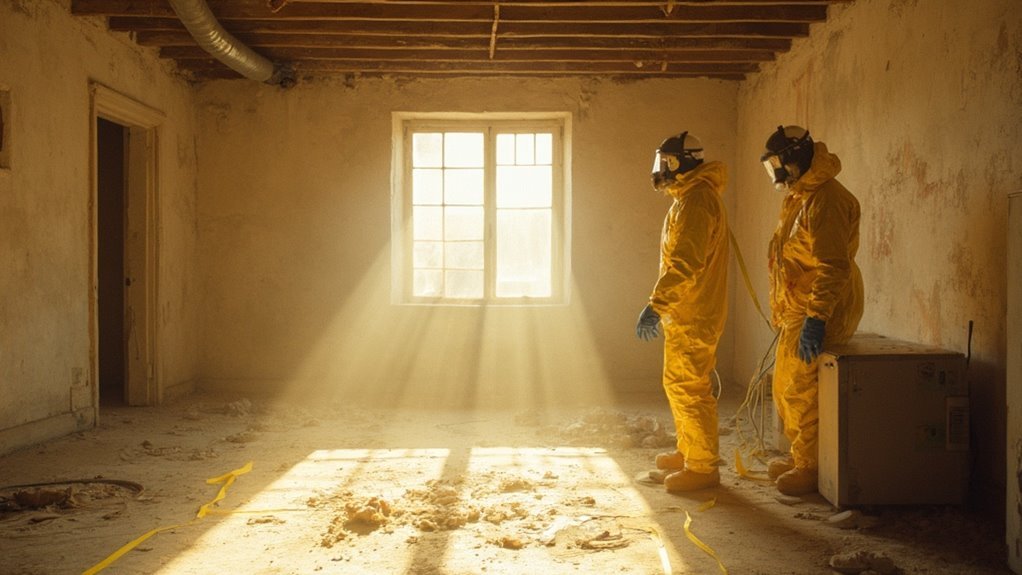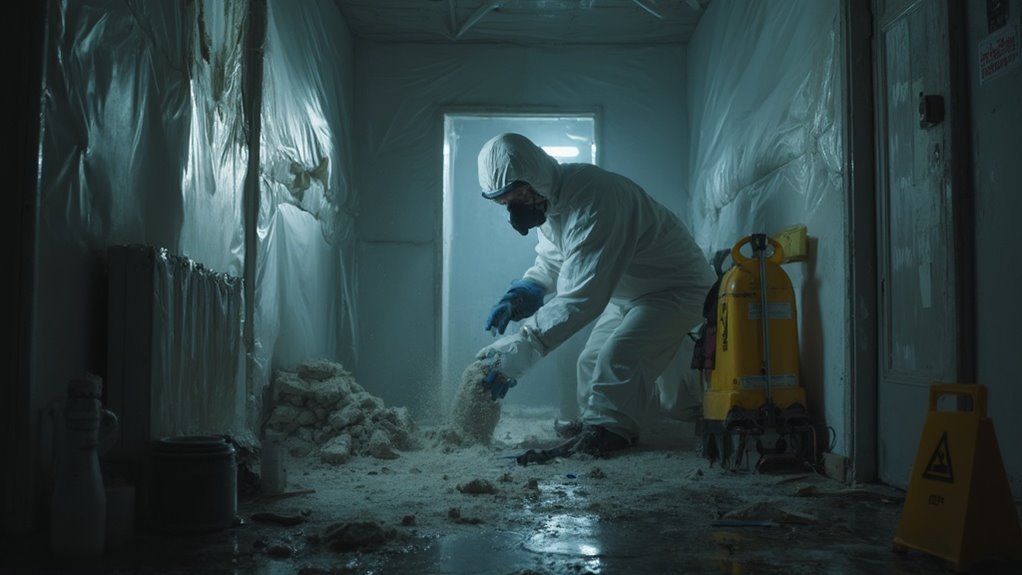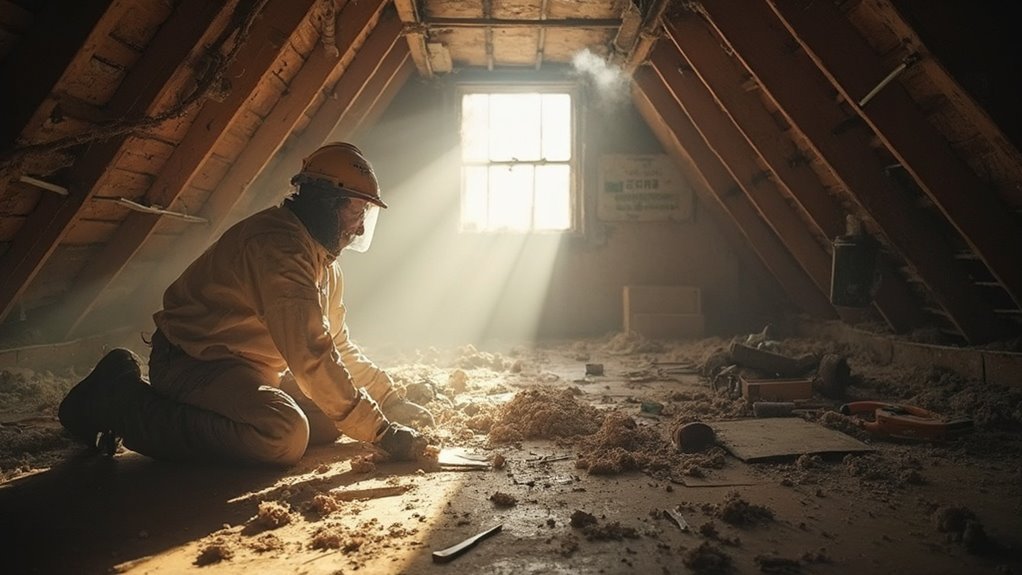Asbestos poses serious health risks, including lung cancer and mesothelioma, making effective abatement essential for your home's safety. Start by identifying potential asbestos-containing materials, commonly found in homes built before the 1980s, like insulation and vinyl floor tiles. Prepare for removal by hiring licensed professionals who follow strict safety protocols during the abatement process. Verify they employ wet methods, containment strategies, and appropriate PPE to minimize exposure. After removal, conduct thorough decontamination and maintain records. Implement ongoing monitoring to keep your environment safe. By following these steps, you can protect your home from asbestos hazards, while learning even more about extensive safety measures.
Understanding Asbestos and Its Risks

Understanding the dangers of asbestos is crucial for safeguarding your health and that of others. Asbestos has a long history of use in construction and manufacturing because of its fire-resistant properties. Nonetheless, it's now classified as a known human carcinogen by the U.S. Department of Health and Human Services, the U.S. Environmental Protection Agency, and the International Agency for Research on Cancer. The health consequences of asbestos exposure are severe, leading to various cancers such as mesothelioma, lung cancer, and larynx cancer.
The risk of developing these diseases increases with heavier and longer exposure. It's alarming to note that the latency period between exposure and the manifestation of cancer can range from 20 to 50 years. Furthermore, asbestos exposure isn't limited to malignant conditions; it can also result in nonmalignant lung disorders like asbestosis and pleural effusions. Asbestos exposure can occur in many industries, with specific groups, such as construction workers, being at higher risk. Additionally, approximately 1,300 Americans die annually from asbestos-related conditions, highlighting the importance of awareness.
Statistics reveal that approximately 1,290 Americans die annually from asbestos-related diseases, emphasizing the urgency of understanding these risks. With 27 million American workers exposed between 1940 and 1980, awareness and proactive measures are critical to prevent further exposure and protect health.
Identifying Asbestos in Your Home
To identify asbestos in your home, start by inspecting common areas where it's often found, such as insulation, roofing, and flooring materials. Look for signs like deteriorating popcorn ceilings, vinyl tiles, or textured plaster that may indicate the presence of asbestos. Knowing these locations and signs is essential for ensuring your safety and planning any necessary abatement. Regular asbestos inspections are crucial for maintaining a safe living environment and identifying potential hazards early on.
Common Asbestos Locations
Many homes built before the 1980s may harbor asbestos in various locations, posing significant health risks. One common area is the attic, particularly if you have vermiculite insulation, which can release asbestos fibers when disturbed. This type of insulation often resembles small pebbles and could be a source of contamination. Asbestos testing is vital here to determine the presence of hazardous materials.
Inside your home, walls and floors can likewise contain asbestos. Look for wallboards, textured finishes, and even certain types of drywall that may have asbestos sandwiched between layers. Vinyl floor tiles, especially those measuring 9×9 inches, are notorious for containing asbestos. Moreover, textured popcorn ceilings and cement sheets used for walls might pose risks.
Outside your home, older roofing shingles and siding materials frequently contain asbestos. Insulation around hot water pipes and tanks, along with external wall sheeting, can also be culprits. If you suspect asbestos in any of these areas, prioritizing safe removal by a professional is vital. Avoid disturbing materials until you've confirmed their safety through testing. Your health depends on it.
Signs of Asbestos Presence
Identifying signs of asbestos presence in your home requires careful observation and knowledge of specific indicators. Look for discolored or brittle materials in insulation, roofing, and siding. Thick joints in eavesheets can likewise suggest potential asbestos. If you notice a fibrous texture in cement siding or see 9×9 inch vinyl floor tiles, these materials may contain asbestos. Textured ceilings, particularly popcorn ceilings, are further indicators.
Homes built before the 1990s are at a higher risk, especially those that haven't undergone significant renovations. Understanding the age and construction practices of your home can aid in identifying asbestos presence. Unfortunately, many asbestos myths downplay the risks, so it's imperative to take them seriously.
While you may consider DIY testing options, professional testing is the most reliable method to confirm asbestos presence. Trained and accredited asbestos professionals should take samples for laboratory analysis, ensuring accurate results. Relying on DIY kits can lead to false negatives or disturb asbestos fibers, increasing risk. Always prioritize safety and get a thorough inspection report detailing the location and condition of any asbestos-containing materials (ACMs) in your home.
Preparing for Asbestos Removal

Before starting the asbestos removal process, you'll need to clear the area of all furniture and personal items. Seal off workspaces with plastic sheeting to contain any potential asbestos fibers, and turn off the HVAC system to prevent contamination of other areas. These steps are essential for maintaining safety and compliance during the abatement.
Clear the Area
Clearing the area is a fundamental step in preparing for asbestos removal, as it sets the stage for a safe and efficient process. First, remove all personal belongings, furniture, and household items from the work area. This minimizes contamination risks and allows workers to access the materials easily. By eliminating obstructions, you guarantee a smoother removal process, which is vital for the safety of both inhabitants and workers.
It's important to understand that some asbestos myths downplay the risks associated with exposure. Proper removal techniques require a clean workspace to identify and isolate asbestos-containing materials effectively. Make certain to assess whether you and your pets need to temporarily relocate based on the extent of the work being done. The asbestos removal team will guide you on this decision.
Before the removal team arrives, conduct a final walk-through to verify everything is clear. Double-check for any remaining obstructions and turn off HVAC systems to prevent the circulation of asbestos fibers. Following these steps will help create a safe environment for the removal process, greatly reducing the risk of exposure to harmful asbestos fibers.
Seal Off Workspaces
Once the area is cleared, sealing off workspaces becomes a top priority to safeguard clean sections of the home from asbestos contamination. You'll need to apply effective workspace isolation techniques to guarantee no fibers escape the affected zones. Start by using thick plastic sheeting to create a barrier around the work area. Secure the edges with heavy-duty tape to achieve a tight seal.
Incorporate portable airlocks if possible, as they aid entry and exit while maintaining containment. Utilize negative air pressure units to draw air into the work area, preventing any potential asbestos fibers from circulating to clean spaces.
It's also vital to clearly mark the boundaries of the contaminated zones. This helps workers and residents identify safe areas and minimizes unnecessary exposure. Remember, physical barriers are fundamental for effective containment methods, so consider using tarps and additional heavy-duty adhesives to reinforce your seals.
Finally, verify all asbestos materials are wetted before removal to reduce fiber release, and follow proper disposal protocols. By implementing these strategies, you'll greatly reduce the risk of asbestos contamination during the removal process.
Turn Off HVAC
Turning off the HVAC system is crucial in preventing asbestos fibers from circulating throughout your home during the removal process. Start by following proper HVAC shutdown procedures to ascertain all heating, ventilation, and air conditioning units are completely turned off and sealed. This action minimizes the risk of asbestos exposure for both occupants and workers.
If necessary, you may need to implement HVAC system modifications to prevent any potential fiber entry during abatement. Carefully assess whether your HVAC system contains asbestos, as this may require additional containment measures. Seal all vents, grills, and access points to further reduce the chance of fiber release.
During the removal process, consider using negative air pressure units to isolate the work area, assuring no airborne fibers spread through the HVAC system. Keep the HVAC system powered down until the removal and thorough cleaning are complete. Afterward, conduct air quality tests to confirm that the environment is safe for re-entry. Only restore the HVAC systems once you've verified that all asbestos-containing materials have been removed and the area is deemed safe. Document all actions taken for future reference.
The Asbestos Abatement Process
The asbestos abatement process is a critical procedure that guarantees safe removal or encapsulation of hazardous materials. It starts with thorough inspection and assessment to identify asbestos-containing materials. You'll then develop a detailed abatement plan that outlines the scope of work, timelines, and safety measures, confirming compliance with legal requirements.
Next, you'll need to notify regulatory agencies and obtain necessary permits before beginning the work. Preparation is key; you'll create a containment strategy to prevent asbestos fiber spread. This involves isolating the work area using impermeable barrier plastic and maintaining negative air pressure with HEPA air filtration devices.
When it comes to removal, employ wet methods to minimize fiber release and use specialized tools like glove bags and tile popper blades. Once the asbestos materials are removed or encapsulated, you'll focus on post-abatement procedures, including thorough cleaning with HEPA vacuums and air quality testing to verify safety levels are met.
Throughout this entire process, using proper safety equipment is crucial to protect yourself and others. By following these abatement techniques meticulously, you confirm a safer environment in your home.
Safety Measures During Removal

During the asbestos removal process, implementing strict safety measures is vital to protect both workers and bystanders from hazardous exposure. Adhering to safety protocols not only safeguards health but additionally guarantees compliance with best practices. Here are key measures to keep in mind:
- Guarantee Area Isolation: Evacuate the building and seal off the perimeter around the work area.
- Use Appropriate Tools: Opt for non-powered hand tools to minimize dust generation.
- Personal Protective Equipment (PPE): Equip yourself with a respirator, safety goggles, gloves, and disposable coveralls.
Worker training is critical; it prepares you to handle materials safely and reduces the risk of fiber release. Regularly wetting down materials before and during removal prevents airborne fibers. Marking the worksite as a hazard area helps keep unauthorized individuals away. After removal, double bag contaminated PPE and guarantee a thorough clean-up with HEPA vacuums. Always shower and wash hair post-job to eliminate any residual fibers. By following these safety measures, you contribute to a safer environment, protecting yourself and others from the dangers of asbestos exposure.
Legal and Regulatory Requirements
Understanding legal and regulatory requirements is fundamental for anyone involved in asbestos abatement. You must comply with federal, state, and local regulations to guarantee safety and legality. The National Emission Standards for Hazardous Air Pollutants (NESHAP) and the Asbestos Hazard Emergency Response Act (AHERA) set the foundation for managing asbestos in various environments, particularly during renovations or demolitions. Regulatory compliance starts with notifying the appropriate state agency before any work that might disturb asbestos-containing materials (ACM).
An asbestos inspection by a certified inspector is imperative. This survey assesses whether ACM will be affected by your project. If asbestos is present, you're required to follow specific abatement procedures, including using personal protective equipment and proper disposal methods. It's likewise important to maintain records of asbestos surveys, abatement plans, and completion certificates; these documents demonstrate compliance and are fundamental for future inspections.
Choosing a Licensed Contractor

Choosing a licensed contractor for asbestos abatement is vital to guaranteeing that the job is done safely and in compliance with regulations. You must verify that the contractor meets specific contractor qualifications and licensing requirements to protect your home and health effectively.
When selecting a contractor, consider these key factors:
- Education and Training: Verify that the contractor has completed an approved training course and passed the necessary exams.
- Experience and Reputation: Assess their experience in asbestos abatement projects and check reviews from past clients to gauge their reliability.
- Insurance and Compliance: Confirm the contractor has liability insurance and adheres to state and federal regulations.
It's important to check the contractor's licensing history for any violations and confirm that their certifications come from accredited providers. Moreover, review state directories for compliance listings. By focusing on these aspects, you can choose a qualified contractor who will handle the abatement process with the utmost care, guaranteeing a safe environment for you and your family. Remember, the right contractor not only completes the job but prioritizes your safety and peace of mind.
After the Abatement Process
After selecting a licensed contractor and completing the asbestos abatement process, it's important to focus on the significant steps that follow to guarantee a safe environment for reoccupation. First, ascertain thorough site decontamination. Your contractor should utilize specialized HEPA vacuum cleaners and wet wiping techniques to eliminate any residual asbestos fibers. Proper material disposal is imperative; removed asbestos-containing materials (ACMs) must be contained in durable, air-tight bags and taken to certified landfills.
Next, conduct clearance testing. This involves extensive air quality monitoring and visual inspections to confirm that asbestos levels meet OSHA regulations. An independent inspection by an industrial hygiene firm is fundamental for validating that the area is safe for reoccupation.
Once the area passes clearance standards, proceed with containment removal and recleaning. It's critical to maintain Post Abatement Safety protocols throughout this phase. Finally, prioritize meticulous Record Keeping. Retain all documentation, including waste shipment records, permits, and clearance testing results, as they are necessary for compliance and future reference. Following these procedures will guarantee a safe environment and peace of mind after the abatement process.
Ensuring Long-Term Safety

To guarantee long-term safety after asbestos abatement, you must conduct regular inspections of the property. These inspections help identify any wear and tear on materials that could release harmful fibers. Furthermore, implementing ongoing maintenance practices will further safeguard against potential asbestos exposure.
Regular Inspections Required
Regular inspections are vital for maintaining safety in buildings with known or suspected asbestos-containing materials, as they help identify potential hazards before they escalate. Following asbestos inspection protocols is imperative. You should adhere to the inspection frequency requirements, which mandate inspections every six months for all known or suspected asbestos materials, especially if your building will serve as a school.
To keep your environment safe, consider the following:
- Conduct initial inspections for buildings used as schools, particularly if they haven't been checked before.
- Regularly inspect your property for any signs of wear and tear on asbestos-containing materials.
- Verify that any demolition or renovation work is preceded by a certified asbestos survey.
Ongoing Maintenance Practices
Implementing ongoing maintenance practices is crucial for guaranteeing long-term safety in environments with asbestos-containing materials. An effective Operations and Maintenance (O&M) program is fundamental. This program should include specific work practices for custodial, maintenance, and construction staff, along with a clearly defined asbestos management policy.
Here's a quick reference table for effective ongoing maintenance practices:
| Task | Description | Frequency |
|---|---|---|
| Routine Cleaning | Use specialized techniques for fiber cleanup | Weekly |
| Training | Make sure staff are trained in asbestos handling | Annually |
| Asbestos Management Policy | Develop and appoint a program manager | As needed |
| PPE Compliance | Verify proper PPE requirements are met | Ongoing |
| Incident Response Procedures | Establish guidelines for fiber release episodes | As needed |
You must additionally verify proper personal protective equipment (PPE) is used to protect staff from exposure. Regularly review and update your O&M plan to reflect any changes in the condition of asbestos-containing materials (ACM). By following these practices, you can greatly minimize risks associated with asbestos.
Resources for Homeowners
Homeowners often face the intimidating challenge of managing asbestos risks in their properties, but several resources are available to help navigate this complex situation. Increasing your asbestos awareness is vital, and you can utilize various homeowner resources to empower your decisions.
- Local Health Departments: Many local health departments offer guidance and resources tailored for homeowners concerned about asbestos. They can help you identify where asbestos may be present and provide inspection referrals.
- Environmental Protection Agency (EPA): The EPA's website contains valuable information about asbestos, including safety regulations, testing guidelines, and abatement procedures. Their resources can help you stay informed and compliant.
- Certified Asbestos Inspectors: Hiring a licensed inspector can be an essential step. They'll assess your property, confirm the presence of asbestos, and help you formulate a safe removal plan.
Frequently Asked Questions
How Long Does the Asbestos Removal Process Typically Take?
Asbestos removal timelines vary considerably. While smaller projects might take 48 hours, complex sites require longer owing to multiple removal phases, area size, and material condition. Your safety hinges on thorough, methodical procedures throughout this process.
Can I Stay in My Home During Abatement?
You shouldn't stay in your home during abatement procedures. Safety precautions are critical, as airborne fibers can pose serious health risks. Leaving guarantees you avoid exposure and allows professionals to work efficiently and safely.
What Should I Do if I Suspect Asbestos?
If you suspect asbestos, don't disturb any materials. Arrange for professional asbestos testing to confirm its presence. Understanding the health risks associated with exposure is vital for ensuring your safety and that of your family.
Is Asbestos Removal Covered by Homeowners Insurance?
Asbestos removal isn't typically covered under homeowners insurance because policy details excluding pollutants. Nevertheless, if removal results from a covered peril, such as fire or storm damage, you may receive insurance coverage for those costs.
How Can I Ensure My Contractor Is Licensed?
Before hiring a contractor, check their credentials. Verify their license through your state's oversight body and confirm they have proper certifications. This verification process protects you from potential hazards and guarantees quality work.
